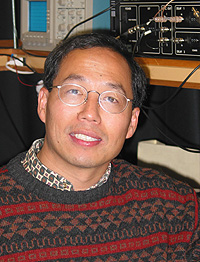Home > Press > UCSC astronomer Sandra Faber and chemist Jin Zhang elected 2007 AAAS Fellows
 |
| Jin Zhang |
Abstract:
Two scientists at the University of California, Santa Cruz--Sandra Faber, University Professor and chair of astronomy and astrophysics, and Jin Zhang, professor of chemistry and biochemistry--have been honored as 2007 fellows of the American Association for the Advancement of Science (AAAS), the association announced this week.
UCSC astronomer Sandra Faber and chemist Jin Zhang elected 2007 AAAS Fellows
Santa Cruz, CA | Posted on October 26th, 2007The council of the 120,000-member society voted this year to award fellowships to 471 scientists and engineers. Each will receive a certificate and commemorative pin during the 2008 AAAS meeting in Boston.
Faber was recognized for "contributions to our understanding of galaxies, dark matter, and the formation of large-scale structure in the universe, and for scientific leadership in the community," according to a AAAS statement.
Faber uses the Hubble Space Telescope and the world's largest ground-based optical telescopes to study how galaxies form, learn about the evolution of structure in the universe, and look for exceedingly faint objects such as nuclear black holes. She has also made significant contributions to the technology used to study the heavens, leading efforts to construct more sensitive spectrographs, which are used to peer across the universe and far back in time.
Faber earned her Ph.D. in astronomy from Harvard in 1972. She joined the faculty of UCSC and the UC Observatories/Lick Observatory the same year and in 1995 was made University Professor, the highest honor for faculty in the UC system. In 2002, Discover magazine named Faber one of the country's top 50 women scientists. She is a member of the National Academy of Sciences, the American Academy of Arts and Sciences, and the American Philosophical Society.
In making Zhang a fellow, AAAS recognized his "distinguished contributions to the field of nanoscience and nanotechnology, particularly ultrafast studies of nanomaterials and their optical applications in energy conversion and biomedical detection."
Zhang's research capitalizes on the peculiar qualities of semiconductors, metal oxides, and metals and investigates how they may be useful as nanomaterials, tiny structures on the scale of atoms. Zhang studies these small structures--illuminated with laser flashes shorter than a billionth of a second--to explore ways to harness light energy for uses such as generating hydrogen fuel from water. His group also studies the use of nanomaterials for detecting cancer biomarkers. He cowrote a textbook, published in 2002, about self-assembly of materials at the nanoscale.
Zhang earned his B.Sc. at Fudan University, Shanghai, and his Ph.D. at the University of Washington in 1989. He joined the UCSC faculty in 1992.
AAAS, the world's largest general scientific society, was founded in 1848 and began its tradition of electing AAAS fellows in 1874. The society's peer-reviewed magazine, Science, is the world's highest-circulation scientific journal, with an estimated total readership of one million. The nonprofit organization is open to all and fulfills its mission to "advance science and serve society" through initiatives in science policy, international programs, science education, and more.
Note to reporters: You may contact Faber at (831) 459-2944 or and Zhang at (831) 459-3776 or .
####
About University of California, Santa Cruz
UC Santa Cruz has a current enrollment of about 15,000 students. Undergraduates pursue course work in 62 majors, and graduate students work toward master's degrees, doctoral degrees, and graduate certificates in 33 academic fields.
In a survey of 60 elite universities, UC Santa Cruz ranked 15th for the percentage of its students whose bachelor's degree led to doctorates. In the UC system, only Berkeley (14th) finished higher.
For more information, please click here
Contacts:
Hugh Powell
(831) 459-2495
Tim Stephens
(831) 459-2495
Copyright © University of California, Santa Cruz
If you have a comment, please Contact us.Issuers of news releases, not 7th Wave, Inc. or Nanotechnology Now, are solely responsible for the accuracy of the content.
| Related News Press |
Academic/Education
![]() Rice University launches Rice Synthetic Biology Institute to improve lives January 12th, 2024
Rice University launches Rice Synthetic Biology Institute to improve lives January 12th, 2024
![]() Multi-institution, $4.6 million NSF grant to fund nanotechnology training September 9th, 2022
Multi-institution, $4.6 million NSF grant to fund nanotechnology training September 9th, 2022
Announcements
![]() NRL charters Navyís quantum inertial navigation path to reduce drift April 5th, 2024
NRL charters Navyís quantum inertial navigation path to reduce drift April 5th, 2024
![]() Discovery points path to flash-like memory for storing qubits: Rice find could hasten development of nonvolatile quantum memory April 5th, 2024
Discovery points path to flash-like memory for storing qubits: Rice find could hasten development of nonvolatile quantum memory April 5th, 2024
Grants/Sponsored Research/Awards/Scholarships/Gifts/Contests/Honors/Records
![]() Discovery points path to flash-like memory for storing qubits: Rice find could hasten development of nonvolatile quantum memory April 5th, 2024
Discovery points path to flash-like memory for storing qubits: Rice find could hasten development of nonvolatile quantum memory April 5th, 2024
![]() Chemical reactions can scramble quantum information as well as black holes April 5th, 2024
Chemical reactions can scramble quantum information as well as black holes April 5th, 2024
|
|
||
|
|
||
| The latest news from around the world, FREE | ||
|
|
||
|
|
||
| Premium Products | ||
|
|
||
|
Only the news you want to read!
Learn More |
||
|
|
||
|
Full-service, expert consulting
Learn More |
||
|
|
||








